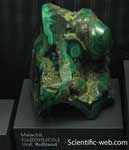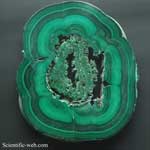| - Art Gallery - |
Malachite is a carbonate mineral normally known as "copper carbonate" with the formula Cu2CO3(OH)2. This green-colored mineral crystallizes in the monoclinic crystal system, and most often forms botryoidal, fibrous, or stalagmitic masses. Individual crystals are rare but do occur as slender to acicular prisms. Pseudomorphs after more tabular or blocky azurite crystals also occur.[3] Etymology and history The stone's name derives (via Latin: molochītis, Middle French: melochite, and Middle English melochites) from Greek Μολοχίτης λίθος molochitis lithos, "mallow-green stone", from μολόχη molōchē, variant of μαλάχη malāchē, "mallow".[4] The mineral was given this name because due to its resemblance to the leaves of the Mallow plant.[5] Malachite was used as a mineral pigment in green paints from antiquity until about 1800. The pigment is moderately lightfast, very sensitive to acids and varying in color. The natural form was being replaced by its synthetic form, verditer amongst other synthetic greens. It is also used for decorative purposes, such as in the Malachite Room in the Hermitage, which features a large malachite vase. "The Tazza", one of the largest pieces of malachite in North America and a gift from Tsar Nicholas II, stands as the focal point in the center of the room of Linda Hall Library. Occurrence and historical uses Malachite often results from weathering of copper ores and is often found together with azurite (Cu3(CO3)2(OH)2), goethite, and calcite. Except for its vibrant green color, the properties of malachite are similar to those of azurite and aggregates of the two minerals occur frequently together. Malachite is more common than azurite and is typically associated with copper deposits around limestones, the source of the carbonate. Large quantities of malachite have been mined in the Urals, Russia. It is found worldwide including in the Democratic Republic of Congo; Zambia; Tsumeb, Namibia; Mexico; Broken Hill, New South Wales; Lyon, France; and in the Southwestern United States notably in Arizona.[6] In Israel, malachite is extensively mined at Timna valley, often called King Solomon's Mines, although research has revealed an interruption in mining activity at the site during the 10th century BC, the time of the biblical Solomon.[7] Archeological evidence indicates that the mineral has been mined and smelted at the site for over 3,000 years. Most of Timna's current production is also smelted, but the finest pieces are worked into silver jewelry. References 1. ^ http://rruff.geo.arizona.edu/doclib/hom/malachite.pdf Handbook of Mineralogy * Hurlbut, Cornelius S.; Klein, Cornelis, 1985, Manual of Mineralogy, 20th ed., John Wiley and Sons, New York ISBN 0-471-80580-7
Retrieved from "http://en.wikipedia.org/" |
|


